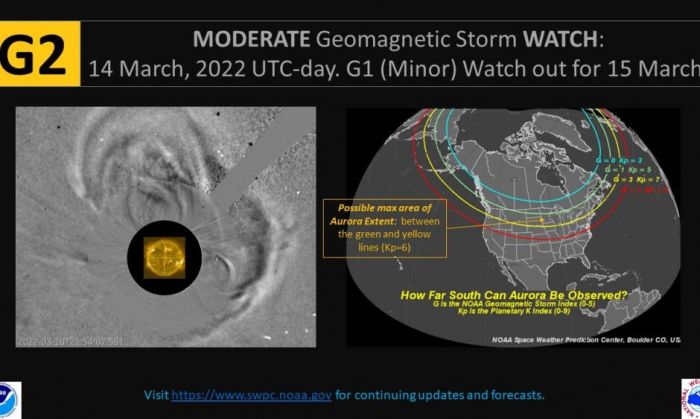The Sun is continuing its rowdy behavior, with flares and coronal mass ejections almost every day since mid-January. That means the inevitable has happened: some of those eruptions have blasted in the general direction of Earth, which means we’re in for some solar storms.
The Space Weather Prediction Center of the US National Oceanic and Atmospheric Administration (NOAA) and the British Met Office have both issued advisories for mild and moderate geomagnetic storms over the next couple of days.
That doesn’t mean we have anything to worry about; in fact, we’ve already been hit by mild and moderate geomagnetic storms over the last couple of days, clocking in at G1 and G2 on the five-level solar storm scale.
This level indicates there may be some degradation of high-frequency radio signals at high latitudes, and corrective actions may need to be taken for satellites due to changes in drag. There may be power grid fluctuations, and some disruption to migratory animals’ activity. And, if the conditions are right, satellites can be knocked out of the sky.
We may also see an uptick of both aurora borealis and aurora australis.
“There is a chance of enhancements to the auroral oval at times during 13th and 14th March as a result of two Coronal Mass Ejections (CMEs) and a coronal hole high speed stream arriving at Earth,” the British Met Office advised. These light shows may be seen as low as 55 degrees latitude, at each pole.
 (NOAA SWPC)
(NOAA SWPC)
Solar storms are pretty normal space weather, occurring whenever our Sun grows more active. As a result, CMEs and solar winds cause disruptions to Earth’s magnetic field and upper atmosphere. Currently, both are happening.
CMEs are pretty much exactly what they sound like. The Sun’s corona – the outermost region of its atmosphere – erupts, ejecting plasma and magnetic fields into space. If the CME is pointed at Earth, the collision of the solar ejecta with Earth’s magnetic field can cause a geomagnetic storm – also known as a solar storm.
Solar winds emerge from ‘holes’ in the Sun’s corona. These are cooler, less dense regions of plasma in the Sun’s atmosphere, with more open magnetic fields. Such open regions allow the solar winds to escape more easily, blowing electromagnetic radiation into space at high speeds; if the hole is facing Earth, those winds can blow right at us.
When charged particles from the Sun hit Earth’s atmosphere, they get channeled along Earth’s magnetic field lines to the poles, where they rain down into the upper atmosphere and interact with molecules therein. This interaction ionizes the molecules and makes them glow; this is the aurora.
According to Space Weather’s aurora forecast, 14 and 15 March have maximum levels of Kp 6 and Kp 5 respectively on the ten-point Kp index of geomagnetic activity. This means a strong possibility of bright, dynamic aurorae with the likelihood of auroral coronae, so it’s a good time to go chasing lights in the sky.
If it seems like the Sun is a bit more active lately, that’s because it is. Our star goes through 11-year activity cycles, with a marked peak and trough, known as solar maximum and solar minimum. Solar minimum, when the Sun’s magnetic field is at its weakest, takes place when the Sun’s magnetic poles switch places. The most recent solar minimum took place in December 2019.
That means we’re currently escalating toward solar maximum, when the solar magnetic field is at its strongest. Because the Sun’s magnetic field controls its activity, this means that we’ll be seeing an uptick in sunspots, solar flares and CMEs. (Sunspots are temporary regions of strong magnetic fields that form when the solar magnetic field tangles.)
Solar maximum is due to take place around July 2025. It can be difficult to predict how active any given cycle is going to be, but there’s evidence to suggest we might be entering the strongest cycle recorded to date.
More powerful solar storms can cause more significant problems, so hopefully our star will keep it relatively low key.
